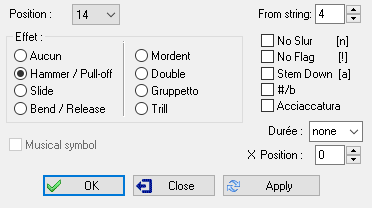Grace note

Also termed "Appoggiatura", these are notes of no definite duration indicating "run-up" notes in the form of an effect. They are represented by a small note just before the main note in the standard notation. In the tablature, they use the "Text 2" font. Basically it is a 1/32th note which is played just before the main note. You can, of course, enter such notes directly in TablEdit but you should use this special function which is not only more convenient but also produces more legible tabs and avoids duration errors.
The cursor must be positioned directly on a previously entered note for the dialog to appear. The dialog can be opened either by selecting this item from the menu, clicking on the "grace note" button in the "Notes" palette or pressing [Alt]+[G].
Enter the position (fret) at which the effect is to begin in the editable field at the top of the dialog and then select the effect to be used from the list.
There are three types of grace notes available to you:
| • | Hammer-on/Pull-off |
| • | Slide |
| • | Bend/Release |
TablEdit also offers you four complex effects:
| • | mordent - (principal note + transitional note + principal note) |
| • | double - (transitional note 1 + transitional note 2 + principal note) |
| • | gruppetto (transitional note 1 + principal note + transitional note 2 + principal note) |
| • | trill (transitional note 1 + principal note + transitional note 1 + principal note...) |
Selecting the "Symbol" check box causes a grace note symbol to be displayed above the notation.
Grace note management
You can perform the following actions:
| To move the small note horizontally, press [>] or [<] (option "X Position"). |
| To remove the flag from the small note, press [ ! ] (option "No Flag"). |
| To delete the connecting slur between the grace note and the principal note, press [N] (option "No Slur"). |
| The grace note stem follows the stem of the principal note. Press [A] to force the grace note to another direction. (option "Stem Down") |
| To change the duration of the grace note, press [ ) ] (option "Duration"). |
| To force the grace note on another string, enter the number of the desired string in the "From string:" field. This type of grace note is preceded in the tablature by a slur that can be avoided with the "No Slur" option |
| To change the alteration of enharmonic grace notes, press [b] (option "#/b"). |
| To play the ornamental note before the beat, select the "Acciaccatura" option. The acciaccatura is drawn as a small eighth note (quaver) with a line drawn through the flag and stem. By applying this attribute to a grace note of the same pitch as the main note AND by specifying a duration, you will not get two repeated notes but you will anticipate the main note by making it start before the beat. |
The right side of the dialog box gives you access to all the advanced options without having to remember the keyboard shortcuts.
Same pitch grace note
It should be noted that if the grace note occupies the same position as the principal note it will not be displayed (nor played) but that its tie will remain visible. This can be of use for notating hammered or slid notes with no distinct point of origin.
Basically, this special kind of grace note allows you to display a slur from nowhere in tablature.
But if you have changed the duration of the grace note (see above), the grace note will be displayed as a normal grace note and played back before the beat.